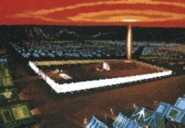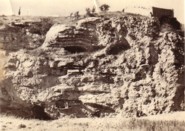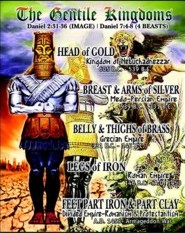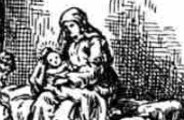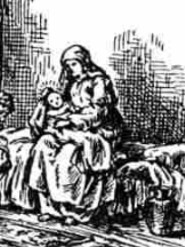The Truth about Easter.
<< prev
next >>
The Origins of Easter.
The word ‘Easter’ is the derived from Astarte (Ishtar), one of the titles of Beltis, the Queen of heaven, whose name, as pronounced by the people of Nineveh, was evidently identical with that now in common use in England.
The worship of Bel and Astarte was very early introduced into Britain, along with the Druids, "the priests of the groves." Some have imagined that the Druidical worship was first introduced by the Phenicians, who, centuries before the Christian era, traded to the tin-mines of Cornwall. But the unequivocal traces of that worship are found in regions of the British islands where the Phenicians never penetrated, and it has everywhere left indelible marks of the strong hold which it must have had on the early British mind. From Bel, the 1st of May is still called Beltane in the Almanac; and we have customs still lingering at this day among us, which prove how exactly the worship of Bel or Moloch (for both titles belonged to the same god) had been observed even in the northern parts of this island. "The late Lady Baird, of Fern Tower, in Perthshire," says a writer in "Notes and Queries," thoroughly versed in British antiquities, "told me, that every year, at Beltane (or the 1st of May), a number of men and women assemble at an ancient Druidical circle of stones on her property near Crieff.
They light a fire in the centre, each person puts a bit of oat-cake in a shepherd's bonnet; they all sit down, and draw blindfold a piece from the bonnet. One piece has been previously blackened, and whoever gets that piece has to jump through the fire in the centre of the circle, and pay a forfeit. This is, in fact, a part of the ancient worship of Baal, and the person on whim the lot fell was previously burnt as a sacrifice. Now, the passing through the fire represents that, and the payment of the forfeit redeems the victim." If Baal was thus worshipped in Britain, it will not be difficult to believe that his consort Astarte was also adored by our ancestors, and that from Astarte, whose name in Nineveh was Ishtar, the religious solemnities of April, as now practised, are called by the name of Easter--that month, among our Pagan ancestors, having been called Easter-monath.
The festival, of which we read in Church history, under the name of Easter, in the third or fourth centuries, was quite a different festival from that now observed in the Romish Church, and at that time was not known by any such as Easter. It was called Pasch, or the Passover, and though not of Apostolic institution, was very early observed by many professing Christians, in commemoration of the death and resurrection of Christ. That festival agreed originally with the time of the Jewish Passover, when Christ was crucified, a period which, in the days of Tertullian, at the end of the second century, was believed to have been the 23rd of March.
That festival was not idolatrous, and it was preceded by no Lent. "It ought to be known," said Cassianus, the monk of Marseilles, writing in the fifth century, and contrasting the primitive Church with the Church in his day, "that the observance of the forty days had no existence so long as the perfection of that primitive Church remained inviolate."
Whence, then, came this observance? The forty days' abstinence of Lent was directly borrowed from the worshippers of the Babylonian goddess. Such a Lent of forty days, "in the spring of the year," is still observed by the Yezidis or Pagan Devil-worshippers of Koordistan, who have inherited it from their early masters, the Babylonians. Such a Lent of forty days was held in spring by the Pagan Mexicans, for thus we read in Humboldt, where he gives account of Mexican observances: "Three days after the vernal equinox... began a solemn fast of forty days in honour of the sun."
Such a Lent of forty days was observed in Egypt, as may be seen on consulting Wilkinson's Egyptians. This Egyptian Lent of forty days, we are informed by Landseer, in his Sabean Researches, was held expressly in commemoration of Adonis or Osiris, the great mediatorial god. At the same time, the rape of Proserpine seems to have been commemorated, and in a similar manner; for Julius Firmicus informs us that, for "forty nights" the "wailing for Proserpine" continued; and from Arnobius we learn that the fast which the Pagans observed, called "Castus" or the "sacred" fast, was, by the Christians in his time, believed to have been primarily in imitation of the long fast of Ceres, when for many days she determinedly refused to eat on account of her "excess of sorrow" (volentia maeroris), that is, on account of the loss of her daughter Proserpine, when carried away by Pluto, the god of hell.
As the stories of Bacchus, or Adonis and Proserpine, though originally distinct, were made to join on and fit in to one another, so that Bacchus was called Liber, and his wife Ariadne, Libera (which was one of the names of Proserpine), it is highly probable that the forty days' fast of Lent was made in later times to have reference to both. Among the Pagans this Lent seems to have been an indispensable preliminary to the great annual festival in commemoration of the death and resurrection of Tammuz, which was celebrated by alternate weeping and rejoicing, and which, in many countries, was considerably later than the Christian festival, being observed in Palestine and Assyria in June, therefore called the "month of Tammuz;" in Egypt, about the middle of May, and in Britain, some time in April. To conciliate the Pagans to nominal Christianity, Rome, pursuing its usual policy, took measures to get the Christian and Pagan festivals amalgamated, and, by a complicated but skilful adjustment of the calendar, it was found no difficult matter, in general, to get Paganism and Christianity--now far sunk in idolatry--in this as in so many other things, to shake hands.
The instrument in accomplishing this amalgamation was the abbot Dionysius the Little, to whom also we owe it, as modern chronologers have demonstrated, that the date of the Christian era, or of the birth of Christ Himself, was mover FOUR YEARS from the true time. Whether this was done through ignorance or design may be matter of question; but there seems to be no doubt of the fact, that the birth of the Lord Jesus was made full four years later than the truth. This change of the calendar in regard to Easter was attended with momentous consequences. It brought into the Church the grossest corruption and the rankest superstition in connection with the abstinence of Lent. Let any one only read the atrocities that were commemorated during the "sacred fast" or Pagan Lent, as described by Arnobius and Clemens Alexandrinus, and surely he must blush for the Christianity of those who, with the full knowledge of all these abominations, "went down to Egypt for help" to stir up the languid devotion of the degenerate Church, and who could find no more excellent way to "revive" it, than by borrowing from so polluted a source; the absurdities and abominations connected with which the early Christian writers had held up to scorn.
That Christians should ever think of introducing the Pagan abstinence of Lent was a sign of evil; it showed how low they had sunk, and it was also a cause of evil; it inevitably led to deeper degradation. Originally, even in Rome, Lent, with the preceding revelries of the Carnival, was entirely unknown; and even when fasting before the Christian Pasch was held to be necessary, it was by slow steps that, in this respect, it came to conform with the ritual of Paganism. What may have been the period of fasting in the Roman Church before the sitting of the Nicene Council does not very clearly appear, but for a considerable period after that Council, we have distinct evidence that it did not exceed three weeks.
The words of Socrates, writing on this very subject, about A.D. 450, are these: "Those who inhabit the princely city of Rome fast together before Easter three weeks, excepting the Saturday and Lord's-day." But at last, when the worship of Astarte was rising into the ascendant, steps were taken to get the whole Chaldean Lent of six weeks, or forty days, made imperative on all within the Roman empire of the West. The way was prepared for this by a Council held at Aurelia in the time of Hormisidas, Bishop of Rome, about the year 519, which decreed that Lent should be solemnly kept before Easter. It was with the view, no doubt, of carrying out this decree that the calendar was, a few days after, readjusted by Dionysius.
This decree could not be carried out all at once. About the end of the sixth century, the first decisive attempt was made to enforce the observance of the new calendar. It was in Britain that the first attempt was made in this way; and here the attempt met with vigorous resistance. The difference, in point of time, betwixt the Christian Pasch, as observed in Britain by the native Christians, and the Pagan Easter enforced by Rome, at the time of its enforcement, was a whole month; and it was only by violence and bloodshed, at last, that the Festival of the Anglo-Saxon or Chaldean goddess came to supersede that which had been held in honour of Christ.
Such is the history of Easter. The popular observances that still attend the period of its celebration amply confirm the testimony of history as to its Babylonian character. The hot cross buns of Good Friday, and the dyed eggs of Pasch or Easter Sunday, figured in the Chaldean rites just as they do now. The "buns," known too by that identical name, were used in the worship of the queen of heaven, the goddess Easter, as early as the days of Cecrops, the founder of Athens --that is, 1500 years before the Christian era. "One species of sacred bread," says Bryant, "which used to be offered to the gods, was of great antiquity, and called Boun."
Diogenes Laertius, speaking of this offering being made by Empedocles, describes the chief ingredients of which it was composed, saying, "He offered one of the sacred cakes called Boun, which was made of fine flour and honey." The prophet Jeremiah takes notice of this kind of offering when he says, "The children gather wood, the fathers kindle the fire, and the women knead their dough, to make cakes to the queen of heaven." The hot cross buns are not now offered, but eaten, on the festival of Astarte; but this leaves no doubt as to whence they have been derived. The origin of the Pasch eggs is just as clear. The ancient Druids bore an egg, as the sacred emblem of their order. In the Dionysiaca, or mysteries of Bacchus, as celebrated in Athens, one part of the nocturnal ceremony consisted in the consecration of an egg. The Hindoo fables celebrate their mundane egg as of a golden colour. The people of Japan make their sacred egg to have been brazen. In China, at this hour, dyed or painted eggs are used on sacred festivals, even as in this country. In ancient times eggs were used in the religious rites of the Egyptians and the Greeks, and were hung up for mystic purposed in their temples.
From Egypt these sacred eggs can be distinctly traced to the banks of the Euphrates. The classic poets are full of the fable of the mystic egg of the Babylonians; and thus its tale is told by Hyginus, the Egyptian, the learned keeper of the Palatine library at Rome, in the time of Augustus, who was skilled in all the wisdom of the native country: "An egg of wondrous size is said to have fallen from heaven into the river Euphrates. The fishes rolled it to the bank, were the doves having settled upon it, and hatched it, out came Venus, who afterwards was called the Syrian Goddess" --that is, Astarte. Hence the egg became one of the symbols of Astarte or Easter; and accordingly, in Cyprus, one of the chosen seats of the worship of Venus, or Astarte, the egg of wondrous size was represented on a grand scale.
The occult meaning of this mystic egg of Astarte, in one of its aspects (for it had a twofold significance), had reference to the ark during the time of the flood, in which the whole human race were shut up, as the chick is enclosed in the egg before it is hatched. If any be inclined to ask, how could it ever enter the minds of men to employ such an extraordinary symbol for such a purpose, the answer is, first, The sacred egg of Paganism, as already indicated, is well known as the "mundane egg," that is, the egg in which the world was shut up. Now the world has two distinct meanings--it means either the material earth, or the inhabitants of the earth. The latter meaning of the term is seen in Gen xi. 1, "The whole earth was of one language and of one speech," where the meaning is that the whole people of the world were so. If then the world is seen shut up in an egg, and floating on the waters, it may not be difficult to believe, however the idea of the egg may have come, that the egg thus floating on the wide universal sea might be Noah's family that contained the whole world in its bosom.
Then the application of the word egg to the ark comes thus:--The Hebrew name for an egg is Baitz, or in the feminine (for there are both genders), Baitza. Thus, in Chaldee and Phenician, becomes Baith or Baitha, which in these languages is also the usual way in which the name of a house is pronounced. The egg floating on the waters that contained the world, was the house floating on the waters of the deluge, with the elements of the new world in its bosom. The coming of the egg from heaven evidently refers to the preparation of the ark by express appointment of God; and the same thing seems clearly implied in the Egyptian story of the mundane egg which was said to have come out of the mouth of the great god.
Extracts from "The Two Babylons"
by Rev Alexander Hislop.

Message Hub...Choose your Language and download Free Messages from Brother Branham











